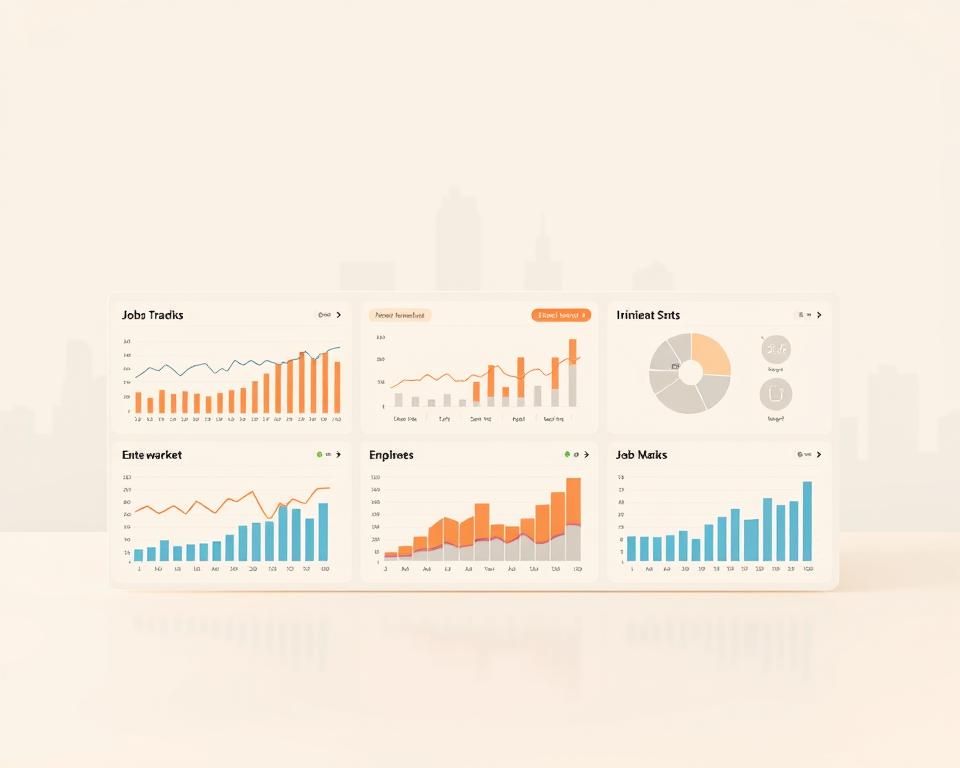Anúncios
Can you read the economy accurately without guessing? This guide shows you how to combine trusted federal figures with faster signals so you can act with confidence.
You’ll get a practical map of where to find and verify the most useful data. We draw on national snapshots and state-level measures, including the U.S. Chamber’s worker-to-opening ratios, Pew Research Center findings on worker satisfaction, and reporting that cites New York Fed and LinkedIn on recent-grad outcomes.
Use these insights for planning, not promises. We’ll explain how to compare records, read signs of cooling or growth in roles, and adapt what you learn to your business, industry, and location.
Expect clear steps, quick checks, and common pitfalls to avoid. If your move is consequential, consider talking with a skilled advisor who can tailor the evidence to your goals.
Introduction: Why sources study job trends matter now
The labor force is a key compass for anyone making plans in today’s shifting economy. You need clear, current measures to time hires, benchmark pay, or choose when to pursue a new role. Small moves based on good data beat big guesses.
Anúncios
The last few years changed the picture sharply. Participation now sits around 62.5–63 percent, down from 63.3 percent in Feb. 2020 and far below 67.2 percent in Jan. 2001. State gaps are extreme: one region may have 41 available workers per 100 openings while another has 153. These differences reshape hiring difficulty and location strategy.
Reliable data lowers your risk. When you base decisions on verified figures, you can set realistic timelines, avoid costly pay surprises, and forecast hiring with more confidence. Surveys also show rising caution: about half of workers report high satisfaction, and 52 percent say finding a preferred role would be difficult—up from 37 percent just a couple of years earlier.
What this report gives you
- Core indicators that set context for your industry and people decisions.
- Practical datasets—federal, regional, and platform feeds—you should check regularly.
- Examples of common misreads and simple cross-checks that keep you on track.
“Use verified measures to adapt your plan, not to promise outcomes.”
How to read the labor market: core metrics that set the context
Start by viewing the market through a compact set of repeatable measures. These metrics tell you who has the upper hand—employers or candidates—and help your business react faster without overreacting.
Openings vs. unemployed: spotting shortages and slack
Compare job openings with the count of unemployed workers to see tightness. Fewer available workers per opening means more competition for employers and more choices for candidates.
Example: some states have about 41 workers per 100 openings, while others show 153 per 100. That gap changes hiring difficulty and pay pressure by location.
- Watch whether openings fall faster than hires—that signals cooling demand.
- Use year‑over‑year comparisons to avoid month-to-month noise.
Labor force participation and demographics
Pair the unemployment rate with participation percent to avoid false signals. A falling unemployment rate can hide people who left the labor force.
LFPR sits near 62.5–63% today versus 67.2% in 2001. Aging and retirements tighten supply even if demand cools, and that varies by occupation and place.
Quit rates, job tenure, and wage trends
Quit rates and tenure read as confidence gauges. Higher quits often mean workers see better options. Stable tenure can indicate caution.
- Track real wages versus inflation to see if pay truly rises (wages are higher than 2000 in real terms).
- Keep a monthly checklist: unemployment, participation, and openings before niche measures.
- Remember: a single percent change rarely tells the whole story.
“Use these measures to adapt your plan — not to promise outcomes.”
Tip: pull the same series over time for your state and nation so your business decisions match current conditions, not last quarter’s assumptions.
Best sources study job trends
Begin by focusing on agencies that deliver consistent, methodical series across time and place. Use each feed for a clear purpose so your business or career moves rest on measurable signals, not guesswork.
Bureau of Labor Statistics (BLS): gold‑standard federal data
Why use it: BLS offers methodologically sound series you can compare across months and states.
What to pull: JOLTS for openings, hires, and quits; CPS for participation and unemployment; OEWS/OES for wages; Business Employment Dynamics for churn; and telework measures for work location shifts.
U.S. Census Bureau: population, education, commuting
Why use it: Census data explains why labor pools differ—population change, education levels, and commuting flows shape where jobs appear.
What to pull: County and metro population trends, educational attainment by age, and commuting matrices to test location strategy.
Federal Reserve (national and regional): macro and special surveys
Why use it: The Fed adds context on credit, demand, and wage pressures that affect hiring plans.
What to pull: National releases for broad cycles and regional bank surveys for early signals on local demand and cost pressures.
“Combine these feeds so each fills a different gap—BLS for consistent series, Census for demographic context, and the Fed for demand and credit color.”
- Match definitions before you compare tables to avoid mixing incompatible measures.
- Pull the exact tables you need and track the same indicators month after month.
- Adjust frequency and depth of checks to your industry cycle and the sensitivity of your hiring or career plans.
Bureau of Labor Statistics: the essential datasets to track
Focus on a handful of BLS series that tell you whether hiring and pay pressure are rising or easing. These tables give concrete signals you can fold into planning for your team or business.
JOLTS: openings, hires, and quits
How it helps: JOLTS shows whether job openings and hires move together or diverge. Rising openings with stable hires suggests growing demand; rising quits point to worker confidence.
CPS and the unemployment rate
How it helps: CPS underpins the unemployment and participation rates. You’ll learn whether a falling rate reflects hiring or people leaving the labor force.
OEWS, Employment Projections, and wages
How it helps: OEWS gives wage percentiles by occupation and metro so you can set realistic pay bands. Employment Projections guide long‑range planning across industries, but treat them as directional.
Business Employment Dynamics for churn
How it helps: BED reveals where positions are created or lost. Use it to plan onboarding, retention, and capacity when your business is expanding or trimming roles.
“Check the same tables monthly, tailor indicators to your field, and document updates and revisions.”
State, regional, and local lenses: finding the signal in your area
National numbers are a starting point; the real story often lives at the state or metro level. You should pivot from broad releases to local dashboards so your hiring or expansion moves fit actual conditions where you operate.
America Works gives a clear, actionable metric: workers per 100 openings. For example, South Dakota shows about 41 workers per 100 openings (a tight market), while California shows roughly 153 per 100 (a surplus). Only ten states show a surplus, so these ratios can change recruiting strategy fast.
America Works Data Center (U.S. Chamber): worker-per-opening ratios
- Use the ratio to set timelines: extend hiring windows in shortage areas and speed screening in surplus markets.
- Compare two regions side by side on openings, wages, and participation to test relocation or expansion cases.
- Blend local postings with the ratio to catch near-term momentum without overreacting.
State labor departments and workforce boards
State releases and workforce boards offer local industry breakdowns, wage tables, and training programs you can tap into. A few percent difference in participation or unemployment can change your plan, so check these feeds quarterly.
“Document your local sources so leadership sees the evidence behind each business choice.”
Real-time market signals: job boards and professional platforms
Online posting feeds often show emerging skills demand before monthly reports reflect them. Use these signals as early warnings, not final answers.
How to use platform data responsibly: pair posting volumes with BLS or state series. A platform dip can be a real cooling sign or a site-specific swing. Cross-check location, title, and industry slices so your comparisons stay apples-to-apples.
Online postings trends and skills demand shifts
Track consistent titles and keywords weekly. Look for sustained percent changes rather than single-week spikes. For example, The Atlantic reports software postings on Indeed fell by more than 50% since 2022.
- Monitor volumes and keyword growth to spot rising skills like AI tool use.
- Translate a posting drop into realistic expectations for response rates and time-to-fill.
- Store observations with privacy-safe labels so your team can reuse the work.
LinkedIn insights: skills, transitions, and hiring pulse
Use LinkedIn skills and hiring pulse to see which industries and workers are moving. Combine that with postings data to test whether a platform signal matches broader market movement.
“Real-time signals inform but don’t replace official sources.”
- Set a weekly quick check cadence to complement monthly official reviews.
- Filter noise by focusing on consistent titles, locations, and industries.
- When postings drop sharply, adjust screening timelines and candidate outreach rather than assuming permanent decline.
Education and early-career dynamics: what’s changing for new grads
Graduates entering the labor market now meet a different set of signals than a decade ago, and that matters for choices about schooling and work.
Recent-grad conditions: The New York Fed estimates recent college grads’ unemployment at about 5.8 percent, while the “recent‑grad gap” sits near record lows. That gap shows entry-level hiring is weaker than the overall market, so you should expect tougher competition for early openings.
Recent-grad unemployment and the “recent‑grad gap”
Higher unemployment for newcomers often reflects timing and mismatch—employers tighten entry hiring first. Use postings and regional hires to see whether your target field still expands junior roles.
The college premium: leveling and implications
Research from the San Francisco Fed shows the college wage premium largely stopped widening around 2010. Postings that require a college degree have fallen as employers favor skills and portfolios in some fields.
- Compare roles that list a college degree with those valuing certificates or skills.
- Evaluate program outcomes by field; majors vary widely in payoff.
- Weigh the cost of more schooling against certificates and on‑the‑job learning for your goals.
“Build experience signals—projects, internships, or apprenticeships—to compete when entry roles are scarce.”
For businesses: recalibrate early-career roles to balance training with productivity. For you, revisit your plan each quarter as demand for specific degrees and skills shifts.
AI and technology as trend shapers
AI is changing tasks more than it is eliminating roles—so far. You should watch entry-level, white‑collar work where summarizing, drafting, and basic analysis are common. Economist David Deming (cited by The Atlantic) highlights these tasks as most exposed to generative models.
Where pressure may appear first
Expect the earliest effects in roles that rely on routine text work and simple data pulls. That includes admin, basic research, and first-draft writing.
Employers may shift those tasks to AI and keep people for oversight, interpretation, and relationship work.
Displacement versus upskilling
Evidence is mixed. LinkedIn’s chief economist finds little proof of broad-scale displacement yet, and a New York Fed survey reports negligible hiring impacts so far. Still, some firms pause entry hiring as they redesign workflows.
- Watch tasks: track postings and role descriptions for “drafting” or “data entry” cuts.
- Prioritize skills: learn prompting, QA, and domain expertise that complement tools.
- Pilot wisely: test small automation projects and measure time‑to‑deliver and error rates.
- Signal readiness: add practical AI tasks to resumes and postings without overstating capability.
- Review quarterly: check AI-related titles and skill tags in your niche to stay current.
“Treat AI as an enabler—use low-risk experiments and clear metrics before changing hiring plans.”
Participation, childcare, and entrepreneurship: forces behind supply
Supply-side forces—aging, caregiving, and new businesses—determine how many people you can hire where you operate.
Aging and retirements have pulled participation down. The labor force participation rate sits around 62.5–63 percent today versus 67.2 percent in 2001. With the 65+ cohort at about 16.8 percent of the population, retirements shrink supply over the decades and raise hiring pressure in some fields.
Aging, retirements, and immigration trends
Immigration slowdowns and fewer young entrants in many states amplify tightness. Some regions will feel a sharper squeeze than others as demographic shifts play out over years.
Childcare access and women’s participation
Childcare access matters. In 2020, 58 percent of working parents left work for care. Women’s LFPR sits near 57.6 percent, with many citing home and family responsibilities. Support policies can move participation and widen your candidate pool.
Record new business applications and flexible work
About 5.5 million new business applications in 2023 show more people trying entrepreneurship or flexible arrangements. That changes how many full‑time workers are available and can lengthen hiring timelines.
“Track these drivers yearly so your plans match the real supply picture, not assumptions.”
- Adjust timelines and wages where retirements and caregiving cut supply.
- Partner on local childcare and training to expand pools.
- Watch school‑age cohorts and business formation for long‑range planning.
Remote and hybrid work: durable shifts to watch
The rise of telework means your location strategy is a planning decision, not just a facilities question.
What the numbers say: in 2024 about 35.5 million people teleworked, up 3.4 percent year over year. Among them, roughly 52 percent used hybrid schedules that mix home and office time.
Telework prevalence and hybrid share
Those figures matter because hybrid arrangements change office footprints and hiring reach. If half of teleworkers use hybrid schedules, you can reduce desk counts and increase remote hiring radius.
Industry differences and location strategy
Not all industries keep the same flexibility. Knowledge roles often stay remote or hybrid. On‑site roles in manufacturing, health care, and stores usually need presence.
- Plan by level: senior and specialized roles tolerate remote work more than many entry tasks.
- Measure quarterly: track application flow, acceptance rate, and retention by work mode.
- Location options: hub‑and‑spoke offices, coworking, and regular in‑person gatherings balance costs and culture.
Practical rule: design role descriptions for the work you can support, not wishful thinking. Align pay, benefits, and expectations to the chosen mix and revisit policies as the economy shifts.
“Treat remote options as tactical levers—use clear metrics and regular reviews to keep them working for your business.”
Worker sentiment and satisfaction: interpreting survey data
Worker surveys reveal a mixed picture: many feel stable but few feel fully rewarded. Pew (Oct. 2024) finds about 50 percent of workers are highly satisfied overall. Only 30 percent are highly satisfied with pay, down from 34 percent.
Job security and intent to switch roles
About 52 percent say finding a desired job would be difficult. That makes people more selective and slower to move.
For you: expect longer recruiting timelines and more weight on stability in offers. Internal mobility can rise if you highlight clear career paths.
Pay, cost of living, and training access
Large shares report pay hasn’t kept up with costs. Roughly 51 percent received training in the past 12 months.
Barriers include time (43 percent), affordability (38 percent), and lack of employer coverage (28 percent). A strict degree requirement can deter candidates when training and pay signals feel weak.
Practical takeaways for hiring and retention
- Compensation strategy: close the percent gap in pay satisfaction by targeted raises or transparent path-to-pay plans.
- Training offers: provide paid learning time, stipends, and clear upskilling levels tied to promotions.
- Messaging: emphasize stability, cost‑of‑living support, and career routes in candidate and employee communications.
- Pulse check: run a quarterly two‑minute survey to compare your team’s sentiment with national benchmarks.
“Read conflicting signals—low unemployment alongside muted satisfaction—by segmenting by income, education, and region before changing plans.”
Skills and training sources: aligning learning with demand
Let market signals guide whether you learn on the clock, earn a certificate, or return to school. Use postings, wage percent changes, and employer listings to pick the fastest path to value.
On-the-job learning, certificates, and formal education
Match the path to the role: pick on‑the‑job if employers list experience and mentorship. Choose certificates when listings require specific tools or platforms. Consider a degree or school program for long‑range career shifts that need formal credentials.
Barriers to training and funding options
Pew finds about 51 percent of workers trained in the past 12 months. Preferences for extra learning: 28% want on‑the‑job, 24% certificates, 24% formal education. Top barriers: time (43%), affordability (38%), and employer coverage (28%).
“Ask for protected hours and a clear ROI—businesses respond when you tie training to productivity.”
- Verify demand: check postings volume, wage uplift, and LinkedIn skills tags before you commit.
- Funding options: tuition assistance, stipends, ETA grants, apprenticeships, and shared-cost plans.
- Make it visible: convert learning into certs, portfolios, internal badges, and milestone reviews.
Quick template to evaluate a provider: outcomes (placement rate), total cost, time‑to‑value, and employer recognition. Revisit your plan each quarter as the market and employer needs change.
Demographics, equity, and inclusion: who gains, who risks falling behind
Different groups experience the labor market in very different ways; that affects policy and hiring choices. You should view these gaps with care and use clear measures, not assumptions.
Age, education, race, and income
What to watch: satisfaction and perceived security vary by income tiers, race/ethnicity, and education levels. Many workers say pay hasn’t kept up with cost of living.
Respect and customer-facing realities
People in manual or visible roles, including those with only a high school background, often report less public respect even when supervisors value them. That affects retention and morale.
- Balance requirements: prefer skills-based screens so candidates without a degree can compete.
- Measure inclusion: track promotion rates, pay equity, and training access by group.
- Practical steps: flexible scheduling, childcare support, and role redesign that opens pathways for high school graduates.
“Use clear indicators and regular reviews so the share of employees who feel seen and supported rises across levels.”
How to triangulate sources and avoid common pitfalls
Treat every striking data point as a question, not an answer. Before you change hiring or pay plans, run a quick verification routine that checks what the number actually measures.
Cross-checking timeframes, definitions, and sample sizes
First, compare definitions: confirm what “employed,” “unemployed,” or “openings” mean in each dataset.
Match timeframes. Don’t compare a monthly platform spike with a year‑over‑year federal series.
Note sample sizes and methodology. Platform postings can shift with classification rules; federal series have revision cycles.
Separating short-term noise from long-term trends
Use simple smoothing: three‑month moving averages for near-term checks and decade‑level context for strategic work.
Keep a changelog. Record queries, tables, release dates, and revisions so your business team knows the level and vintage of each figure.
“Confirm notable moves with two independent feeds before you act.”
- Check definitions first.
- Match month, quarter, or year before comparing.
- Evaluate sample size and representativeness.
- Track revisions and annotate one‑off events (policy, strikes, reclassifications).
- Triangulate: require two independent confirmations for big decisions.
When to escalate: if indicators conflict and the result could change hiring, investment, or staffing levels, get an expert review.
Adapt this checklist to your risk tolerance and your business context; it guides action without promising certainty.
Building your own job-trend dashboard
Create a lean dashboard that turns federal releases and platform signals into clear, repeatable checks. Keep it simple so updates take minutes, not hours.
Monthly markers to track
- Unemployment rate and participation percent.
- JOLTS: openings, hires, and quits (watch divergence).
- Platform postings and local vacancy feeds to catch early momentum.
Quarterly and annual reviews
Every quarter add Fed regional surveys and a Pew-style worker sentiment snapshot to balance hard data with behavior. Annually review OEWS wages and BLS Employment Projections to guide budgeting and long-range growth planning.
Personalize by industry, occupation, and location
Tag charts by sector, metro, and role so the dashboard reflects the workforce you hire or pursue. Add a traffic‑light system: green for steady, amber for caution, red for material change that warrants action.

“Store queries, notes, and thresholds so updates are repeatable and leaders trust the view.”
Conclusion
CTake these final notes as a quick playbook to adapt your plan as conditions shift.
, You’ve seen how to blend gold‑standard feeds with timely signals so your next business move or career step rests on evidence. Conditions vary by state, age, and education; recent grads still face higher unemployment than the wider market. Telework stays durable, and worker satisfaction is mixed despite low unemployment.
Match the mix to your role, location, and stage—whether you hold a college degree, lead people, or hire for growth. Review your dashboard often and update assumptions before major choices.
If the stakes are high, consider talking with a trusted advisor who can translate the data into decisions that fit your goals. Keep your approach simple, consistent, and adaptable.



